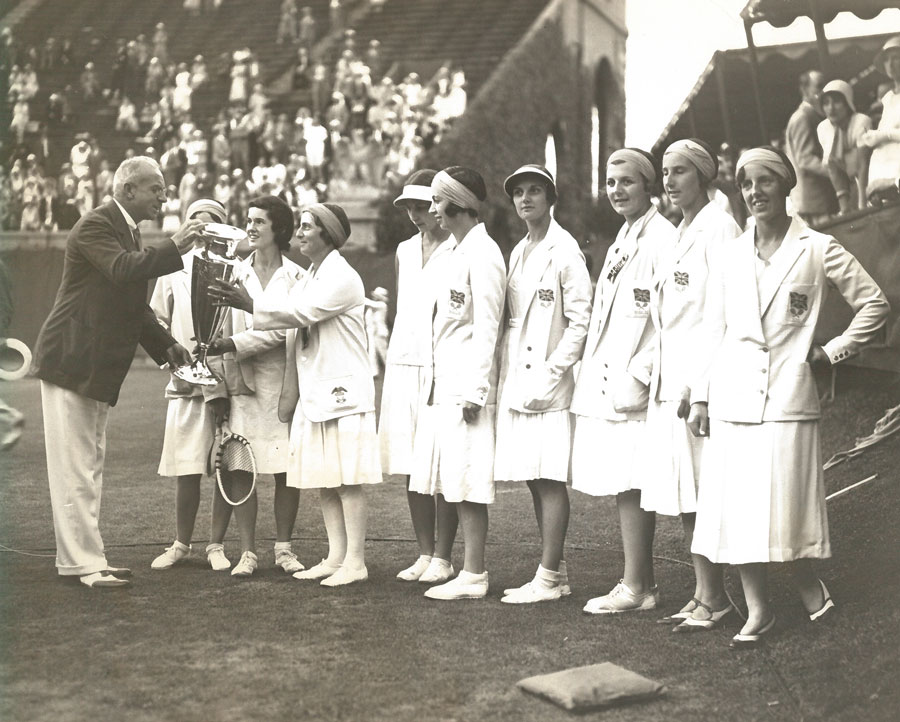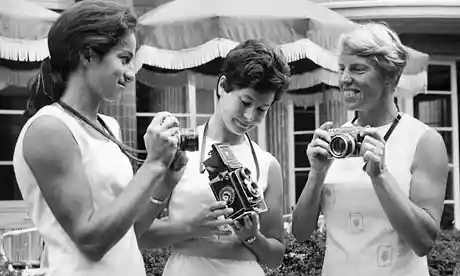Let’s take a break today from 1973 and dial it back another half-century, to August 11th, 1923.
One hundred years ago today, Forest Hills overflowed with tennis firsts. The United States and Great Britain opened the new Wightman Cup competition. Helen Wills and Kitty McKane–two women who were considered the greatest hopes to dislodge Suzanne Lenglen at the top of the game–faced off for the first time. And they did it all at a brand-new stadium, playing the first-ever matches at the 13,000-seat concrete horseshoe at the West Side Tennis Club.
The Wightman Cup was the brainchild of Hazel Hotchkiss Wightman, a four-time national singles champion and tireless promoter of the game. She grew up in California and enjoyed her first tennis success there. In 1910, she won a match at the Washington State Championships without losing a single point. After her marriage to Bostonian George Wightman in 1912, she set up shop in the East. She won her fourth national title in 1919, when she was already a mother of three.
Wightman donated a silver cup in 1920 as a trophy for a proposed international competition for women. She was thinking of something along the lines of Davis Cup, which had debuted in 1900 and since expanded to include eight nations. Other countries showed interest in a women’s equivalent. But few women players traveled internationally to compete, so scheduling and expense proved insurmountable.
Finally, a strong contingent of British players sailed to play the U.S. circuit in 1923. They would enter the national championships, so the scaled-down Wightman Cup would be staged between two teams–the British visitors and the American hosts–immediately before that tournament. The sides settled on a modified version of the Davis Cup format. Instead of four singles matches and one doubles over three days, they would play five singles and two doubles across two days.
Hazel Wightman’s involvement in the inaugural event didn’t end with the name on the trophy. While she had mostly retired from singles play, she was still one of the top doubles competitors in the world. She captained the squad and would play number one doubles with Eleanor Goss. Leading the singles charge would be Wills, who Wightman had coached years earlier in Berkeley.
It’s tough to know which was a bigger draw: The new stadium, or the 17-year-old Wills, who had finished second at the 1922 national championships. The event was scheduled to run on Friday and Saturday, August 10th and 11th. The opening was postponed when President Calvin Coolidge declared a national day of mourning for his predecessor, Warren Harding, who had died in office. Instead, the new facility would open its doors on the 11th, and the second day of Wightman Cup matches would coincide with the first day of the national championships on Monday the 13th.
New York’s tennis faithful was undeterred by the schedule change. 5,000 of them came out to see Wills take on McKane, reigning national champion Molla Mallory face Mabel Clayton, and the Wightman/Goss duo battle McKane and Phyllis Covell. Latecomers didn’t miss much: The day began with speeches and dedications befitting what was now, after Wimbledon, the second-largest tennis facility in the world.
The opening matches didn’t disappoint. Wills-McKane was a contrast in styles, between Helen’s power forehand and the Brit’s assured net game. Wills hit as hard as anyone, even the famously slugging Mallory. Her deep forehands were too much for McKane, and she took the first set, 6-2.
McKane, however, was hardly one to shy away from a fight. She was the one player who actually sought out chances to challenge the great Lenglen, and at the World Hard Court Championships in Brussels the previous year, she had taken Suzanne to 8-8 in the first set before fading away. Against Wills, she charged back, unleashing a barrage of overheads to take a 5-2 lead in the second. Helen, however, was already developing the demeanor that would earn her the “Ice Queen” nickname. She steadily made her way back. She fought through four deuces at 2-5 to stay in the set, and ultimately finished the job in straights, 6-2, 7-5.
Mallory had an easier time of it against the overmatched Clayton. The score was similar to that of the first rubber–6-1, 8-6–but by the time the British challenger made her move in the second set, she was physically fading. The Norwegian-American champion kept up the pressure–and the power that had been known to knock the racket out of opponents’ hands–to give her adopted homeland a 2-0 series lead.
The doubles match surpassed everything that had come before. The 36-year-old Wightman–less than 18 months after giving birth to her fourth child–was the star of the show. With Goss scampering around the background, Wightman manned the net, “smashing everything within her reach,” as the New York Times summarized. The veteran’s volleying prowess remained unmatched, though McKane flashed some acrobatics of her own.
The Americans took the hard-fought opening set, 10-8. The Brits, who made up for a slight talent deficit with sharp teamwork, recovered to grab the second, 7-5. After the customary 10-minute break, the visitors ran out to a 3-0 lead. But Wightman didn’t intend to surrender her cup so easily. The home side won six of the next seven games and the match, 6-4.
* * *
The Americans completed the sweep two days later. They dropped only one more set, when Geraldine Beamish snuck away with a 6-0 second frame against Goss. Wills and Mallory picked up their second victories with identical scores of 6-2, 6-3. They finished the day as a team with a similarly routine defeat of Beamish and Clayton.
The Wightman Cup remained a staple of the women’s tennis calendar for decades. However, it never followed in the steps of the Davis Cup and expanded beyond two teams. The United States and Great Britain alternated hosting duties every year until 1989, except for the six years of World War II.
There was no international women’s competition of the sort Hazel Wightman first envisioned until 1963, when he ILTF finally launched the Federation Cup. The Brits reached the semi-finals of the first edition, but the true powerhouses would be the United States and Australia. The first Federation Cup final turned into a battle between Margaret Smith and Billie Jean Moffitt, who would each claim a singles match before locking horns in a doubles showdown eventually won by Moffitt and Darlene Hard.
As women’s tennis spread across the globe, the Brits lost their prominence. The multi-country event has changed its name twice, and Team GB is still looking for its first Billie Jean King Cup title. By the 1930s, the Wightman Cup was lopsided in favor of the Americans, and Open tennis reduced its appeal even more. Top U.S. players often skipped it, and by the mid-1980s, the event became a showcase for American prospects such as Zina Garrison and Jennifer Capriati.
The Wightman Cup finished its 67-year run in 1989. Like so many vestiges of the amateur era, it didn’t really have a place on the modern calendar, and it is rarely missed.
The Cup outlived its donor by 15 years. Hazel Wightman remained a fixture on the Boston tennis scene until the end. She continued playing top-level doubles into her 60’s, collecting a runner-up trophy at the National Indoors in 1946. She captained the Wightman Cup team until 1948. In “retirement,” she spent much of her time running tournaments and sending out invitations: She ran a popular women’s singles event during the national doubles championships, and she started the first national tournament for collegiate women.
Many of her invitees ended up staying at the Wightman house, a chaotic jumble of dirty laundry and racket covers when tournaments were in progress. Hazel coached a handful of national champions and mentored countless others.
The horseshoe at the West Side Tennis Club is gone; top-level tennis no longer has an event with the Wightman name on it. The US Open got a bigger, more modern stadium in 1978. But the sport will never have another figure quite like Hazel Wightman.
* * *
Subscribe to the blog to receive each new post by email:

